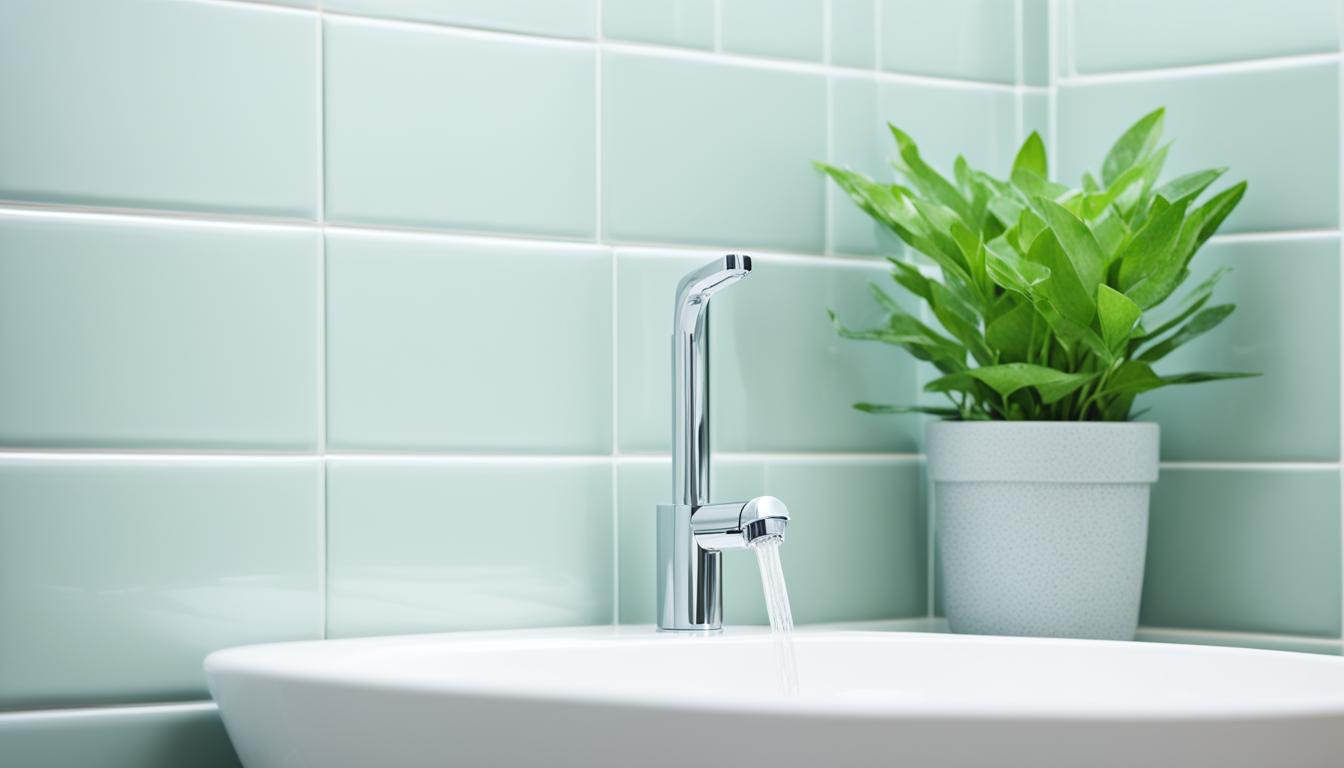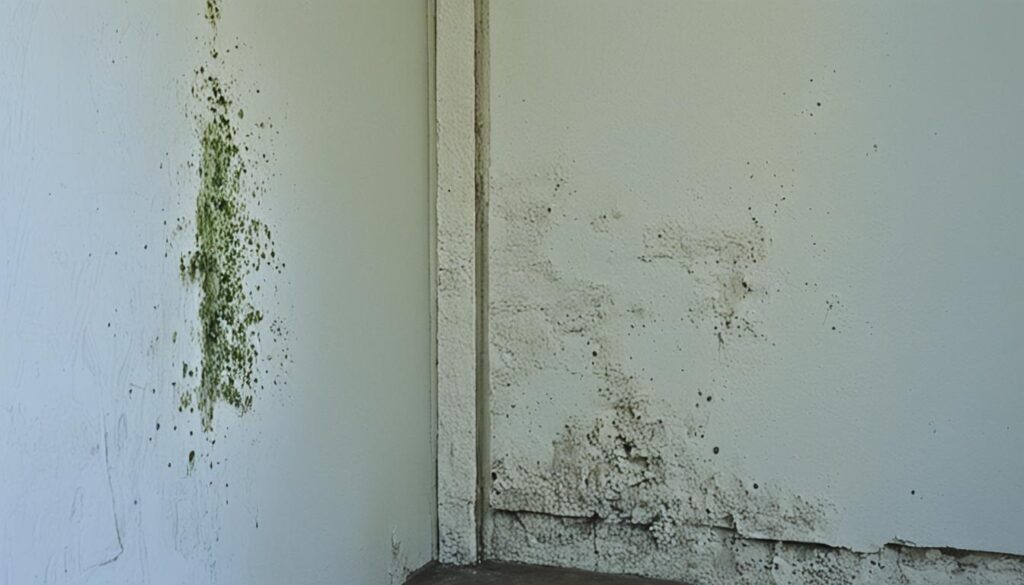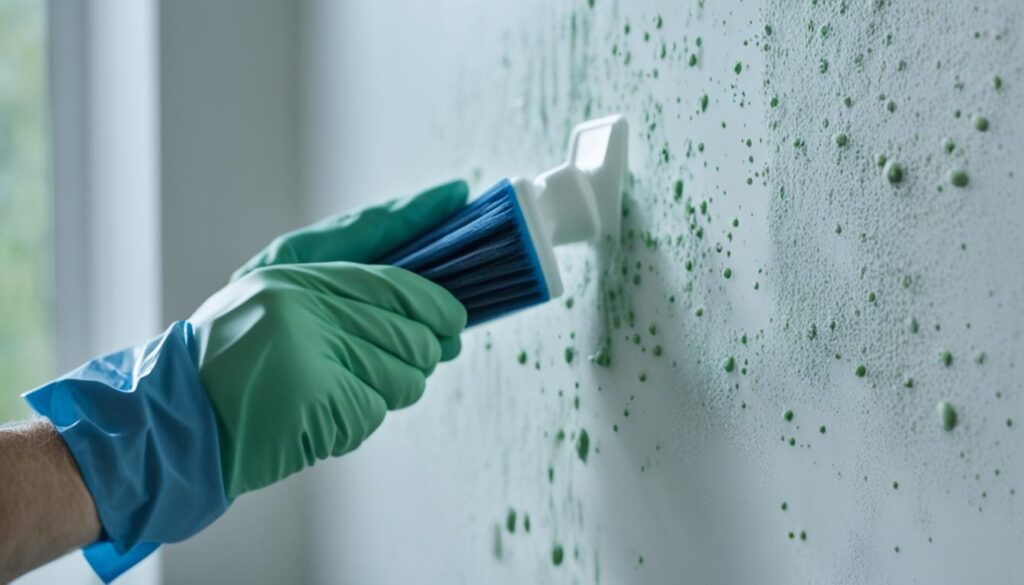
Mold? Prevention & Remediation Tips for Homes
Welcome to our comprehensive guide on mold prevention and remediation for homes. Mold can be a persistent and harmful issue, affecting both the health of residents and the integrity of the structure. In this section, we will provide expert tips and strategies to help you protect your home from mold and create a healthy living environment.
Mold prevention is essential to maintain a safe and comfortable living space. By implementing proactive measures, you can significantly reduce the risk of mold growth and its associated problems. Additionally, having effective mold remediation strategies can help you eradicate existing mold and prevent future recurrence.
Key Takeaways:
- Implementing mold prevention techniques is crucial for maintaining a healthy home environment.
- Regular mold testing and inspection can help identify and address potential mold issues.
- Controlling moisture and humidity levels is key to mold prevention.
- Mold remediation should be carried out promptly and effectively to eliminate existing mold problems.
- Preventive measures and timely remediation can contribute to a mold-free home and better overall well-being.
Understanding Mold Growth and Risks
When it comes to maintaining a healthy living environment, understanding mold growth and its associated risks is imperative. Mold, including various types such as black mold, can impact both your health and the structural integrity of your home. By gaining insight into mold growth and its potential dangers, you can take proactive steps to address and prevent indoor mold.
Mold is a common fungus that thrives in damp and humid conditions. It can be found both outdoors and indoors, with the latter posing a significant concern for homeowners. Indoor mold growth often occurs in areas where moisture accumulates, such as bathrooms, kitchens, basements, or any other place affected by water leaks, condensation, or high humidity levels.
The presence of mold in your home can lead to various health problems. Some individuals are more sensitive to mold than others, experiencing allergies, respiratory symptoms, or even severe reactions. The severity of these health issues largely depends on factors such as the type of mold present, the extent of exposure, and an individual’s overall health condition.
In addition to health risks, mold can cause significant damage to your home. If left untreated, mold growth can compromise the structural integrity of building materials, leading to costly repairs. It can also trigger unpleasant odors and create an unsightly appearance in affected areas.
Types of Mold
There are numerous types of mold that can be found in homes. One of the most notorious types is black mold, also known as Stachybotrys chartarum. Black mold is characterized by its dark greenish-black appearance and slimy texture. While all mold should be treated with caution, black mold is particularly concerning due to its potential health risks.
Other common types of indoor mold include Aspergillus, Penicillium, Cladosporium, and Alternaria. Each type has its own unique characteristics and may thrive in different conditions. Understanding the specific type of mold in your home can help determine the best course of action for remediation.
It’s important to note that mold can often be difficult to identify visually, especially in hidden areas such as inside walls or beneath flooring. If you suspect mold growth in your home but can’t visibly see it, professional mold testing and inspection may be necessary to assess the extent of the problem.
“Mold growth can have serious consequences for both your health and your home’s structural integrity. Understanding the different types of mold, including black mold, and the risks associated with indoor mold growth is crucial.”

Impact on Health
Mold can have a range of adverse health effects, especially on individuals with respiratory conditions, allergies, or weakened immune systems. Exposure to mold spores can lead to symptoms such as nasal congestion, coughing, wheezing, throat irritation, and skin or eye irritation. In some cases, prolonged exposure or high levels of mold can result in more severe reactions, including respiratory infections or exacerbation of underlying health conditions.
Furthermore, certain molds produce mycotoxins, which are toxic substances that can cause additional health problems if inhaled or ingested. Black mold, in particular, is known to release mycotoxins that can lead to respiratory issues, allergic reactions, and neurological symptoms in susceptible individuals.
To minimize the health risks associated with mold, it’s crucial to address any signs of mold growth promptly. By taking proactive measures to prevent and remediate mold, you can safeguard your well-being and maintain a safe living environment.
Continue reading to explore effective mold prevention techniques for your home in the next section.
Mold Prevention Techniques for Your Home
Preventing mold from taking hold in your home is crucial for maintaining a healthy living environment. By implementing effective mold prevention techniques and conducting regular mold testing and inspection, you can safeguard your space from the harmful effects of indoor mold growth.
Identifying Potential Sources of Moisture
To prevent mold, it’s essential to identify and address potential sources of moisture and humidity in your home. Start by checking for any leaks in pipes, roofs, or windows. Repairing these issues promptly will help minimize the risk of mold development.
Additionally, ensure proper ventilation in areas prone to moisture, such as bathrooms, kitchens, and basements. Use exhaust fans or open windows to reduce humidity levels and promote airflow. Proper airflow helps keep surfaces dry and prevents mold from thriving.
Maintaining Optimal Indoor Humidity Levels
Monitoring and controlling indoor humidity levels is crucial in mold prevention. Aim to keep humidity levels between 30% and 50% to create an environment where mold growth is less likely.
If your home experiences high humidity, consider using dehumidifiers to remove excess moisture from the air. These devices are particularly useful in damp areas, such as basements and crawlspaces.
Regular Mold Testing and Inspection
Mold testing and inspection are key components of mold prevention. Regularly assessing your home’s indoor air quality and conducting mold tests can help detect and address mold issues before they worsen.
Consider hiring a professional mold inspector to assess your home thoroughly. They have the expertise to identify hidden mold growth and potential problem areas. By conducting regular inspections, you can take proactive measures to prevent mold infestation.
Proper Ventilation and Air Circulation
Proper ventilation and air circulation are essential in mold prevention. Ensure that rooms are adequately ventilated by opening windows or using fans in moisture-prone areas. This helps to prevent the accumulation of excess moisture and creates a less favorable environment for mold growth.
Furthermore, consider using air purifiers equipped with HEPA filters. These filters can capture mold spores and other airborne pollutants, improving the indoor air quality of your home.
Potential Sources of Moisture
| Area | Description |
|---|---|
| Bathroom | Check for leaks from faucets, showers, and pipes. Ensure proper ventilation to prevent excessive moisture. |
| Kitchen | Inspect sinks, dishwashers, and refrigerator water lines for leaks. Properly vent cooking areas to minimize steam and humidity. |
| Basement | Look for cracks in the foundation and ensure proper drainage. Waterproofing measures may be necessary in areas prone to excessive moisture. |
| Attic | Check for roof leaks, condensation, and inadequate insulation. Proper ventilation is crucial to prevent moisture buildup. |
| Crawl Space | Inspect for standing water, inadequate ventilation, and exposed soil. Proper drainage and encapsulation can help prevent moisture issues. |
By implementing these mold prevention techniques and diligently monitoring your home for potential risks, you can create a mold-free environment for you and your family to enjoy.
Mold Remediation Strategies for a Mold-Free Home
When it comes to mold, prompt action is crucial. Mold can spread rapidly and pose health risks to you and your family. In this section, we will explore effective strategies for removing mold from your home and creating a mold-free environment. Whether you prefer a do-it-yourself approach or need to enlist professional help, we’ve got you covered.
1. Identify and Address the Source
The first step in mold remediation is to identify and address the source of moisture or humidity that is fueling mold growth. It’s common for mold to develop in areas with water damage, leaks, or excessive moisture. Inspect your home thoroughly and fix any issues that contribute to mold growth. This may involve repairing plumbing leaks, improving ventilation, or addressing condensation problems.
2. DIY Mold Removal
If the affected area is small and the mold growth is minor, you may be able to tackle the removal process yourself. Start by protecting yourself with gloves, goggles, and a face mask to prevent exposure to mold spores. Scrub the affected area with a mixture of water and detergent, and use a scrub brush or sponge to remove the mold. After cleaning, thoroughly dry the area to prevent further mold growth.
Keep in mind that DIY mold removal is only suitable for small patches of mold. If you’re dealing with a larger area or suspect the presence of toxic black mold, it’s best to consult with a professional mold remediation service to ensure a safe and thorough removal.
3. Professional Mold Remediation
For extensive mold growth, toxic black mold, or if you prefer expert assistance, hiring a professional mold remediation service is recommended. These professionals have the knowledge, experience, and specialized equipment to effectively remove mold and prevent its recurrence.
“Professional mold remediation services offer a comprehensive approach to mold removal, ensuring that all affected areas are thoroughly cleaned and treated. They can also provide valuable advice on mold prevention strategies to maintain a mold-free home.” – John Smith, Mold Remediation Expert
4. Preventing Mold Recurrence
After successfully removing the mold from your home, it’s crucial to take preventive measures to avoid its return. Here are some key steps to prevent mold recurrence:
- Keep humidity levels below 60% by using dehumidifiers or improving ventilation.
- Repair any leaks or water damage promptly.
- Clean and dry any areas impacted by water or moisture within 24-48 hours.
- Use mold-resistant products in areas prone to mold growth, such as bathrooms and basements.
- Regularly inspect and maintain your HVAC system to prevent moisture buildup.
By following these preventive measures, you can significantly reduce the risk of mold reappearing in your home, ensuring a mold-free and healthy living environment for you and your family.

With these mold remediation strategies, you can effectively remove mold from your home and create a mold-free environment. Remember, swift action is key when dealing with mold growth. Whether you choose the DIY route or enlist professional help, addressing mold issues promptly will help protect your home and your health.
Conclusion
Mold prevention and timely remediation are crucial for maintaining a healthy and mold-free home environment. Throughout this article, we have explored various tips, techniques, and strategies to tackle mold issues. By implementing these steps, homeowners can protect their living spaces from mold growth and mitigate the risks associated with black mold and other types of indoor mold.
To prevent mold, it is essential to address potential sources of moisture and humidity. Regular mold testing and inspection can help identify areas prone to mold growth, allowing for prompt intervention. Additionally, maintaining proper ventilation and controlling moisture levels will significantly reduce the chances of mold colonization.
In the event of mold infestation, swift and effective remediation is essential. DIY options can be suitable for small, localized areas of mold, but professional mold remediation services are recommended for extensive or persistent mold problems. Proper mold removal techniques ensure the elimination of mold spores and minimize the risk of reoccurrence.
By prioritizing mold prevention, implementing preventive measures, and promptly addressing mold issues, homeowners can enjoy a mold-free living environment that promotes their well-being and the structural integrity of their homes. Remember to regularly inspect and maintain your property to keep it safe from the damaging effects of mold. Protect your home and take action against mold today.




